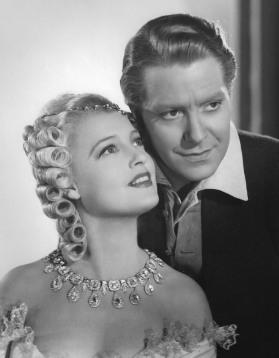 Jeanette MacDonald & Nelson Eddy in New Moon
Jeanette MacDonald & Nelson Eddy in New MoonA year or two back, I published a series of articles devoted to the incongruities of opera stars appearing or being featured in Hollywood movies (yes, you heard that right — even the silent variety), and of Hollywood movies employing said opera stars.
I later realized, to my dismay, that a cluster of mini-pieces I had prepared on the subject of opera and moviedom never quite made it to the “final cut.” Whether for reasons of space, or most likely the failure of these pieces to fit into any specific group or category that I had been thinking about, I never got around to a definitive solution for their use. In all probability, they wound up on the proverbial cutting-room floor.
Nevertheless, I’d like to make amends and take this opportunity to rectify my oversight by offering these “short takes, outtakes, and out-and-out mistakes” as a consolation to movie buffs and opera lovers starved for the offbeat and out-of-the-way in musical film fare.
So, as they say in showbiz: “Here goes nothing!”
Yes, But Were They Opera Singers?
A subsection of the class of performers who sang and acted their way to stardom in a multiplicity of motion pictures involves all those Deanna Durbin, Jeanette MacDonald and Nelson Eddy vehicles so beloved of fans of the Depression years. Coming as they did before and during the conflagration known as World War II, we can look back on these ventures with more than a clear-eyed appreciation for their relative merits and deficiencies.
Let’s get the show on the road with the young and gifted Deanna Durbin. Born Edna Mae Durbin on December 4, 1921, to British émigré parents in Winnipeg, Manitoba (bet you didn’t know she was Canadian, ay?), Deanna’s family relocated to Southern California, i.e., the Los Angeles area, when she was two years old due to her father’s health.
Originally scheduled to appear in a planned 1935 production opposite the Austrian contralto Ernestine Schumann-Heink — it was going to be another of those Hollywood “biopics,” this one of the grande dame herself, in which Durbin was supposed to play Schumann-Heink as a child — the project was scrapped due to the singer’s untimely passing. That alone would turn most aspirants off. Instead, the rechristened Deanna co-starred a year later in an MGM short, Every Sunday, alongside another potential discovery, the plucky thirteen-year-old Judy Garland.
As ill luck would have it, Garland was in and Durbin was out. It sounds suspiciously like one of those producer clichés (of the “The kid stays in the picture” variety). But the scuttlebutt around Tinsel Town was that Louis B. Mayer, the titular lord of Metro-Goldwyn-Mayer’s realm, took one look at Every Sunday and that very day made his fateful decision: “Get rid of the fat one,” he declared. His subordinates misunderstood Mayer’s pronouncement and promptly canned Ms. Durbin, when in fact he meant to fire the pudgy Ms. Judy. Details, details!
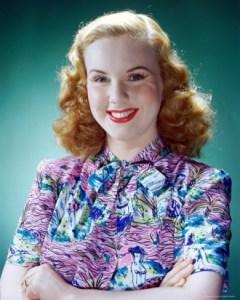
That being the case, the production team at Universal, Joe Pasternak (who later migrated to MGM) and Henry Koster, snapped up the budding starlet and signed Durbin to make her feature debut in Three Smart Girls (1936), a smart move on their part. Deanna’s role was that of a smart cookie, sharing screen time with Nan Grey and Barbra Read, the other brains of the outfit.
This was soon followed by the hugely successful One Hundred Men and a Girl (1937), wherein the guileless Deanna played second fiddle, in a manner of speaking, to the real star of the show: the world renowned, long-haired music-maker, maestro Leopold Stokowski. This was several years before “Stokie” had bowed to (in animated-silhouette form, I might add) and shook the celluloid hands of the cartoonish Mickey Mouse in Walt Disney’s cult classic, Fantasia.
The basic plot of One Hundred Men and a Girl involved an aspiring vocalist (Deanna) trying to convince the skeptical conductor to hire her unemployed father and his ragtag group of equally jobless musicians (all of them veterans of a depressed economy) to play in an ad hoc symphony — presided over by Leopold himself. It’s a charming period piece, a harmless bit of Depression-era diversion, with the thoroughly enchanting Durbin at her uncomplicated best.
Her singing voice, while sounding slight and reedy on top (in this author’s opinion, not very distinctive even at this early stage in her career), manages to hit all the right notes in a pleasant if passable reading of the “Alleluia” section from Mozart’s concert aria, Exsultate Jubilate, along with other characteristic pieces from the period. Durbin is ably seconded by a typical 1930s cast of characters, including the dapper Adolphe Menjou as her ne’er-do-well dad, bullfrog-throated radio-station owner Eugene Pallette, Alice Brady as his wife, blustering Billy Gilbert as a garage owner, Frank Jenks as a cab driver (a role he repeated in many a picture), and the resourceful Mischa Auer as a flute player.
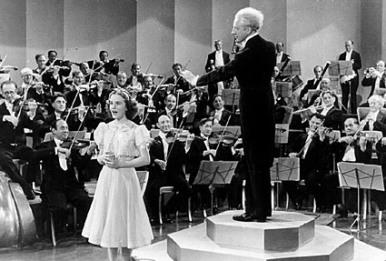
Mad About Music (1938) was the next entry in the Durbin canon, followed by such items as That Certain Age, Nice Girl?, It Started with Eve, and numerous others. Durbin’s films were notable primarily for their unabashed innocence and easy-to-take charm, their A-list casting of such top-drawer talents as Charles Laughton, Robert Cummings, Franchot Tone, and Robert Stack, and near-top of the line production values — although to be perfectly honest they were a few steps below the best that rival studio MGM had to offer.
Still, it was that very ordinariness, a quality that Durbin so attractively exuded in many of her screen portraits that tugged at people’s hearts. Later in 1938, she shared a special Academy Award with fellow child star Mickey Rooney for (and I quote) “bringing to the screen the spirit and personification of youth … and by setting a high standard of ability and achievement.”
Notwithstanding her appeal as a non-threatening, girl-next-door type, in 1948 Ms. Durbin decided to retire from the screen at the advanced age of 27. By then, Deanna had flowered into a fully matured and, it must be noted, boldly voluptuous figure. Two films from 1944, the first, Christmas Holiday, in which she portrayed a New Orleans hooker of all things, and the other, Can’t Help Singing, a Technicolor musical Western that showed her in a bathtub surrounded by frothy bubbles, left little to the imagination and pretty much burst her bubble of wholesomeness for all time.
Relocating to Paris, Deanna married (for the third time, if you’re keeping track) a Frenchman by the name of Charles Henri David. She was rarely seen or heard from until her death, at 91, in April 2013. Durbin left behind a series of lightweight pictures that, while totally ingenuous in their makeup and design, held classical music in high regard.
Although popular with the middlebrow crowd, Deanna accepted the fact that she attracted mostly older audiences, her reasoning being that she “represented the ideal daughter millions of fathers and mothers wished they had.” You may take a bow for that statement, dearie.
Ah, Sweet Mystery of Life!
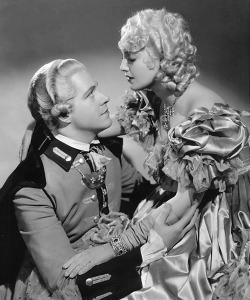
British-born critic and irascible raconteur, David Thomson, had a lot to say about our next pair of candidates for screen stardom: “It is possible that, without so accomplished a soprano voice, Jeanette MacDonald would now be more highly regarded as a comedienne. Without a song, she would not have had to keep company with the egregious Nelson Eddy.” Ouch, that hurt!
What Thomson may not have considered was that Ms. MacDonald’s career-defining affiliation with the robust-toned Mr. Eddy was exactly what the war-weary American public wanted and kept clamoring for during their unbroken string of hits between the years 1935 and 1942.
After all, what was Laurel without Hardy, Abbott without Costello? And, righty put, what was Jeanette MacDonald without Nelson Eddy? Ah, but there’s the rub! For you see, both stars, whether separately or as a melodious unit, had forged onscreen personalities so tailored to their own that, without regard to their individual talents, would forever be associated in people’s mind with the most winning (and, nowadays, the campiest) movie musicals in film history.
Born in Philadelphia, PA, in 1903 (or 1901, depending on your source), Jeanette Anna MacDonald was the youngest of three girls, one of whom was the actress Marie Blake, a.k.a. Blossom Rock, best known to TV addicts as Grandmama on The Addams Family series. Blessed with a lyrically-trained voice and above-average acting and dancing skills, young Jeanette came to New York in 1919, later making headway on the Great White Way in a variety of shows, revues and light operas from 1920 onward.
Discovered, after a fashion, by screen veteran Richard Dix and European film director Ernst Lubitsch, MacDonald burst onto the scene in a series of lushly filmed, suave and sophisticated musical comedies for Paramount Pictures, co-starring the dashingly urbane French sensation, Maurice Chevalier. They made four movies together, the first of which, The Love Parade in 1929, is an excellent example of what came to be known as the “Lubitsch touch.” Indeed, MacDonald and Maurice made beautiful music together (while he made goo-goo eyes at his partner), but their subsequent output failed to ignite the spark that the fast-moving Love Parade had started.
Having better luck with The Vagabond King (1930), which highlighted the rich baritone rumblings of the strikingly handsome British subject, Dennis King (Fra Diavolo or The Devil’s Brother), MacDonald jumped ship for other studios — among them United Artists and Fox Film Corporation — for a round of musical parfaits that exploited the artist’s growing popularity on the big screen. Several classics resulted, including another coupling with Monsieur Chevalier in One Hour with You and Love Me Tonight (both in 1932), along with a few others.
All this activity caught the attention of our old friend, Louis B. Mayer, who had been trying to sign up the busy singer-actress for a goodly number of years. Mayer’s luck was about to change, however, when after two unsuccessful efforts at MGM, including a sound remake of The Merry Widow (1934), directed by Lubitsch and featuring the debonair Chevalier again, the studio hit pay-dirt when Jeanette MacDonald was eventually paired with newcomer Nelson Eddy in the film version of Victor Herbert’s operetta Naughty Marietta.
A classically trained singer with an easy top and sturdy build, Eddy hailed from Providence, Rhode Island. Two years older than MacDonald, he was no less talented than his future working partner. After the early divorce of his parents, Eddy went to live in Philadelphia, Jeanette’s old hometown, where he began his vocal studies. Employed at a variety of jobs (among them a clerk and a newspaper reporter), young Nelson entered and won several voice competitions, all of which landed him recurring opportunities at the Philadelphia Civic Opera.
By the time he and MacDonald had joined together in song, Eddy had made numerous concert and opera appearances with the likes of maestro Stokowski, sopranos Helen Jepson and Elizabeth Rethberg, conductor Fritz Reiner, tenor Giovanni Martinelli, bass Ezio Pinza, and composer Ottorino Respighi. There was even mention of his name joining the illustrious ranks of other American baritones of the time, i.e., Lawrence Tibbett (himself a movie star), John Charles Thomas, and Richard Bonelli. Hey, Figaro!
With that background, was it any wonder that MGM had nothing but the greatest difficulty in placing the tall, blond-haired and boyish-looking Eddy in non-singing parts? In total, Eddy and MacDonald appeared in eight feature films, many of them directed by W.S . Van Dyke or Robert Z. Leonard or both, beginning with Naughty Marietta and followed by Rose Marie (1936), Maytime (1937), The Girl of the Golden West (1938) based on David Belasco’s play, Sweethearts (1938), New Moon (1940), Bitter Sweet (1940), and culminating with I Married an Angel in 1942.
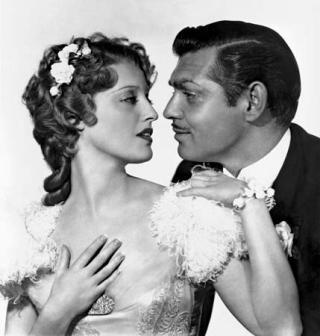
Both artists left MGM shortly thereafter. On their own, they had mixed results, as well as mixed reviews from audiences and critics alike; basically it was hit or miss. By herself, Jeanette MacDonald went on to star in several pictures, the most prominent being San Francisco (1936) with Clark Gable and Spencer Tracy (where Jeanette warbled the Jewel Song from Gounod’s Faust), The Firefly with Allan Jones (1937), Broadway Serenade (1939) with Lew Ayres, Smilin’ Through (1941) with Brian Aherne and her husband Gene Raymond, Cairo (1942) with Robert Young and Ethel Waters, and Three Darling Daughters (1948) with Jane Powell and José Iturbi. Her final film, The Sun Comes Up (1949), presented audiences with her strangest partner yet: the dog Lassie!
With other leading ladies, Nelson Eddy received top billing in Rosalie (1937) with Eleanor Powell, Let Freedom Ring (1939) with Virginia Bruce, Balalaika (1939) with Ilona Massey, The Chocolate Soldier (1941) with Risë Stevens, and Northwest Outpost (1947), again with Massey. He also starred in Universal’s The Phantom of the Opera (1943) with Susanna Foster and Claude Rains, Knickerbocker Holiday (1944) with Charles Coburn, and as an opera-singing cartoon whale in Disney’s Make Mine Music (1946).
There were rumors of a tempestuous affair between Mr. Eddy and Ms. MacDonald, both on and off the screen. It’s even been said that Nelson asked Jeanette to marry him on more than one occasion: each time, she turned him down flat. Were they longtime lovers, or just very close friends? Who knows?
What we do know is that both MacDonald and Eddy were born in the month of June, almost two years apart. She died in 1965, while he passed on in 1967 — a little over two years later. Must be another of those sweet mysteries of life they so often sang about.
The Golden Girls
It’s been said that all of Louis B. Mayer’s taste was in his mouth. Whether this observation was indeed true or not, Mayer could still boast of having had under contract three of MGM’s most conspicuous sirens: sopranos Ann Blyth, Kathryn Grayson and Jane Powell. All three were known as the Metro Girls, for better or worse — the jewels in the studio’s musical crown in its postwar heyday.
The main reason for their popularity, besides good looks and more than decent acting chops, was their voices — both speaking AND singing voices, to be exact. You can read all about these fabulous artists in Brian Kellow’s fact-filled essay, “The Lost Metro Girls,” in the August 2002 issue of Opera News. For our purposes, let’s say that all three ladies had been bitten by the theater bug at an early age, with opera rarely or tangentially entering into the picture.
Ann Marie Blyth, who grew up in New York City, took part in the children’s chorus at the budding San Carlo Opera Company. One might even have gotten wind of her performances, back in the day, in such perennial items as Puccini’s La Bohème and Bizet’s Carmen, if only as part of the onstage crowd. Blyth also flexed her stage muscles in the Broadway production of Watch on the Rhine with Paul Lukas.
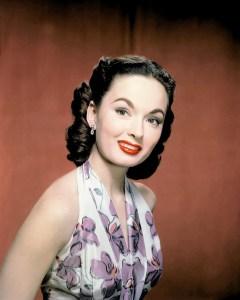
On tour with the play in L.A., Blyth was noticed by a talent scout and promptly hired by Universal Pictures. But it was with MGM that she came into her own in straight acting parts, the most memorable of which, as Joan Crawford’s spoiled brat of a daughter in Mildred Pierce (1945), earned her an Academy Award nomination. Within a few years, she graduated from playing an offspring to being the cinematic wife of Enrico Caruso, as well as the mother of his child.
Notwithstanding her brief take on the number, “The Loveliest Night of the Year,” from the Mario Lanza vehicle The Great Caruso (1951), viewers got to hear Blyth’s beautiful singing voice in a series of elaborately produced operettas, beginning with remakes of Rose Marie and The Student Prince (all from 1954), and the ersatz Vincente Minnelli-directed Kismet, a poorly received box-office dud.
Unfortunately, Blyth’s singing voice was dubbed by pop star Gogi Grant in her next musical outing, the soap-opera filming of The Helen Morgan Story from 1957, about the alcoholic torch singer’s troubled life. Blyth wisely retired from the screen later that same year. As you can see, opera hardly fit into the picture at all with someone whose “early career” began on the stage.
Such was not the case with Metro’s other golden girl, Zelma Kathryn Grayson. A native of Winston-Salem, Grayson’s family moved to St. Louis, where she began serious vocal studies, even learning the part of Lucia di Lammermoor. Another of the many Hollywood transplants, the young songbird continued studying, right up until the moment Louis Mayer spotted her at a concert and, in true “I’ll show ‘em who’s boss” fashion, signed her to a film contract.
Claiming never to have fought with the legendary old haggler, Grayson was deprived of a Metropolitan Opera debut as Lucia by the ever-watchful Mr. Mayer. In Kellow’s article, L.B. is quoted as saying, “If [Grayson] is known as an opera star, she’ll have a short career. If she is a motion picture star, she’ll be a star forever.” This was the polar opposite of Met Opera General Manager Rudolf Bing’s attitude toward his own stable of stars (for example, baritone Robert Merrill) and their moonlighting antics as Hollywood actors.
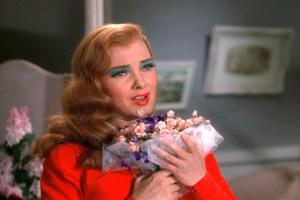
For years, Grayson was left waiting in the wings. She eventually came out for her bow in the late 1940s in the first two Mario Lanza pictures, That Midnight Kiss from 1949 and The Toast of New Orleans in 1950. Their legendary tussles filled the gossip columns with scathing accounts of off-screen battles and prima donna-like behavior (on Mario’s part, not Grayson’s). After The Great Caruso, Mr. Lanza’s Metro star began to wane; Ms. Grayson’s, however, was slowly but surely on the rise. She starred opposite Howard Keel in the Technicolor remake of Show Boat which, through no fault of her own, many critics (myself included) felt was inferior to the 1936 version with Irene Dunne and Allan Jones.
Still, Grayson and Keel made a good team, and gave fans their money’s worth in two return engagements, first with Lovely to Look At (1952), followed by the best of their three-picture deal together, the movie version of Cole Porter’s musical Kiss Me, Kate (1953). Grayson’s man-hating harpy Katherine, coupled with her temperamental comportment as Lilli, was one of the real-life Kathryn’s finest screen portrayals, a pouty, tantrum-prone shrew that people wrongly associated with the actress herself.
Not so, for once her movie career was over Grayson continued to pursue her first love — i.e., singing on the stage — appearing in touring companies of Lerner and Loewe’s Camelot, Verdi’s La Traviata, Donizetti’s Lucia, and Puccini’s La Bohème and Madama Butterfly, as well as going the nightclub route all over the continental U.S.
Despite her fame in filmdom, and contrary to Louis B. Mayer’s prediction, Kathryn Grayson became both an opera star AND a movie star, forever. Her voice was finally silenced on February 17, 2010, at age 88.
Keep on Smiling
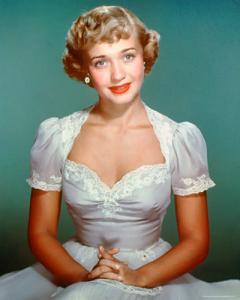
The last of the highly-touted Metro Girls, bubbly Jane Powell, was the least inclined of the threesome toward a career on the operatic stage. The possessor of a sparkling personality and a winning 100-watt smile, the bright-eyed and bushy-tailed Jane distinguished herself through many onscreen appearances, all the while weathering numerous vocal crises for almost the entire length of her stint in La-La-Land.
As far as we could tell, Ms. Powell, a Portland, Oregon native, never sang or starred in opera. Yet, her sharply focused soprano would be heard in such varied assignments as A Date with Judy (1948) and Nancy Goes to Rio (1950), both with Carmen Miranda, Royal Wedding (1952) with singer-dancer Fred Astaire, Three Sailors and a Girl (1953) with Gordon MacRae, Seven Brides for Seven Brothers (1954) with the omnipresent Howard Keel, and Hit the Deck (1955) with crooner Tony Martin.
She also made it a point to appear in musical theater. A partial listing of her activities includes such classic shows as Oklahoma!, The Sound of Music, Carousel, My Fair Lady, and Brigadoon. But Powell, who was born Suzanne Lorraine Burce, earned the first of her positive notices on the air, prophetically on the radio program Stars of Tomorrow. She entered the cinema at the tender age of fifteen, playing a variation on her own vivacious identity as a perky, sincere, and overly enthusiastic ingénue with the cherubic face and a never-say-die outlook on life.
Married five times, the last (and still current) of which is to former child actor Dickie Moore, Powell was put under contract to MGM. Ironically, though, her movie debut occurred over at Universal, Deanna Durbin’s home studio, in the 1944 feature Song of the Open Road. How’s that for a prescient title? From then on, it was work, work, and more work for the industrious Ms. Jane, who was anything but plain in her “forever young” screen traversals.
Louis B. Mayer had finally found a replacement for Deanna Durbin, who he always felt had slipped through his studio’s fingers. However, by the mid-1950s movie musicals were on their downward slide. As far as her future film endeavors went, Powell saw the handwriting on the wall clearly enough. She left the pomp and vanity of Tinsel Town for the stage, making a second go at a theater career: she was ideally cast, in 1973, as Debbie Reynold’s replacement in the Broadway hit Irene.
Still experiencing trouble with her vocals, Ms. Powell soon called it a night. She is fondly remembered by her legions of fans as that never-aging, eternally jovial youth who lit up many a movie musical with her lyrical output and sun-drenched optimism.
Recommended Reading:
- Citron, Marcia. Opera on Screen, Yale University Press, New York, 2000.
- Dizikes, John. Opera in America: A Cultural History, Yale University Press, New Haven and London, 1993.
- Fawkes, Richard. Opera on Film, Duckworth Publishers, Great Britain, 2002.
- Katz, Ephraim. The Film Encyclopedia, HarperPerennial, A HarperCollins Book, New York, 1994.
- Kellow, Brian. “The Lost Metro Girls,” The Crossover Variations — Opera, Broadway and the Movies, Opera News Magazine, Volume 67, Number 2, August 2002.
- Mackay, Harper. “The History of Hollywood’s Secret Voices,” Opera News Magazine, October 1994.
- Midgette, Anne. “Verdi On-Screen: A Century’s Operatic Riches,” The New York Times, January 25, 2002.
- Myers, Eric. “Universal Appeal, The Crossover Variations — Opera, Broadway and the Movies,” Opera News Magazine, Volume 67, Number 2, August 2002.
- Scherer, Barrymore Laurence. “The Flickering Light: Der Rosenkavalier and Other Silent Opera Films,” Opera News Magazine, December 11, 1993.
- Schroeder, David. Cinema’s Illusions, Opera’s Allure, Continuum Books, New York, 2002.
- Wlaschin, Ken. “Glory of Opera Films That Hit the Right Notes,” The Los Angeles Times, November 15, 2000.
- Wlaschin, Ken. Opera on Screen: A Guide to 100 Years of Films and Videos, Beachwood Publishers, 1997.
Copyright © 2014 by Josmar F. Lopes

